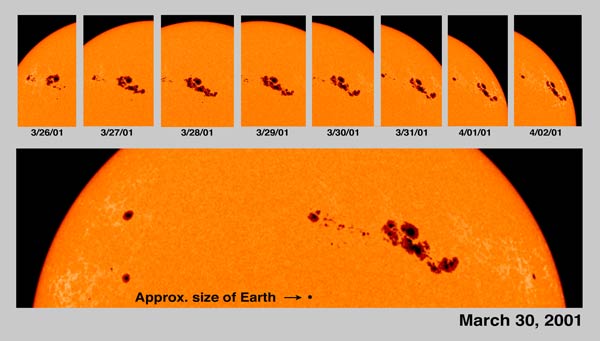
Sunspots can trigger major eruptive events on the solar surface, which can lead to widespread power outages on Earth as well as wreaking havoc on telecommunication and navigation systems. But researchers in the US say that they have developed a technique that could detect emerging sunspots a full day or two before they appear.
Although scientists have been observing and documenting sunspots for more than 400 years, the origin of these cool, dark regions of strong magnetism on the solar surface have remained largely mysterious. Theories suggest that they are formed from complex motions of hot plasma inside the Sun. The idea is that acoustic waves that form near the surface propagate deep inside the Sun before returning to the surface at a different location because of refraction.
Emerging storms
Now, Stathis Llonidis and colleagues at Stanford University have taken this theory as the basis for a technique to locate the emergence of sunspots within the interior of the Sun. Llonidis’ team uses a specific helioseismology technique – called time–distance helioseismology – to analyse the time taken for these acoustic waves to propagate through the solar interior.
The technique involves selecting a pair of points on the solar surface separated by a specific distance between 100,000–200,000 km. Some of the acoustic waves excited near the location of one of these points will propagate 60,000 km into the Sun before returning to the surface near the location of the corresponding point. It usually takes about one hour for the acoustic waves to make this journey. However, if the waves pass through an emerging sunspot, then they speed up and the journey time is reduced slightly – for a large sunspot region this effect is about 12–16 s.
“In reality, we don’t select only one pair of points on the surface but thousands of pairs of points,” explains Llondis. From these data the researchers compute the travel times and then produce a travel-time map that identifies locations in the solar interior where the travel time is shorter. “We know that at these locations there is an emerging sunspot region.”
Up to two days’ warning
To test the technique, Llondis’ team used data collected by the Heliospheric Observatory (SOHO) and the Solar Dynamics Observatory (SDO) missions. They looked at four regions with emerging sunspots and nine quiet regions with no sunspots. Large sunspots were usually detected a day in advance and smaller sunspots detected up to two days in advance – because large sunspots are more buoyant and move to the surface faster. In contrast, the regions with no sunspots did not show significant travel-time anomalies.
The researchers believe that these findings prove that the detection of emerging sunspots is now possible, although they caution that they still need to analyse a large number of regions to test the robustness of their model. “Only after we do this, we will be able to know if we can predict the emergence of sunspots and how reliable our predictions are,” says IIonidis.
Llondis feels that the research could lead to a better understanding of the properties of the magnetic field in the deep solar interior, as well as having practical implications related to space-weather forecasting. “The Sun is a magnetized star. Much of the solar activity is related to the properties of the magnetic field, so we want to learn more about these properties,” he adds. “That’s why we study sunspots, because sunspots are the most prominent manifestation of solar magnetism in the photosphere [the solar surface].”
The research is published in Science.



